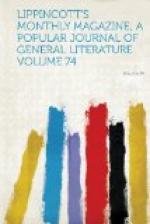[Illustration: Garrick’s villa.]
Garrick’s house is separated from its bit of “grounds,” which run down to the water’s edge, by the highway. It communicates with them by a tunnel, suggested by Johnson. It was not a very novel suggestion, but the excavation deserves notice as probably the one engineering achievement of old Ursus major. We may fancy the Titan of the pen and the tea-table, in his snuffy habit as he lived and as photographed by Boswell, Mrs. Thrale, Fanny Burney, and their epitomizer Macaulay, diving under the turnpike and emerging among the osiers and water-rats to offer his orisons at the shrine of Shakespeare. For, in the fashion of the day, Garrick erected a little brick “temple,” and placed therein a statue of the man it was the study of his life to interpret. The temple is there yet. The statue, a fine one by Roubillac, now adorns the hall of the British Museum, a much better place for it. Garrick, and not Shakespeare, is the genius loci.
[Illustration: RIVER SCENE, THAMES DITTON.]
This is but one, if the most striking, of a long row of villas that overlook the river, each with its comfortable-looking and rotund trees and trim plat in front, with sometimes a summer-house snuggling down to the ripples. These riverside colonies, thrown out so rapidly by the metropolis, have no colonial look. We cannot associate the idea of a new settlement with rich turf, graveled walks and large trees devoid of the gaunt and forlorn look suggestive of their fellows’ having been hewn away from their side. The houses have some of the pertness, rawness and obtrusiveness of youth, but it is not the youth of the backwoods.
Bob and sinker are in their glory hereabouts. Fishing-rods in the season and good weather form an established part of the scenery. From the banks of the stream, from the islands and from box-like boats called punts in the middle of the water, their slender arches project. It becomes a source of speculation how the breed of fish is kept up. Seth Green has never operated on the Thames. Were he to take it under his wing, a sum in the single rule of three points to the conclusion that all London would take its seat under these willows and extract ample sustenance from the invisible herds. If perch and dace can hold their own against the existing pressure and escape extinction, how would they multiply with the fostering aid of the spawning-box! We are not deep in the mysteries of the angle, but we believe English waters do not boast the catfish. They ought to acquire




